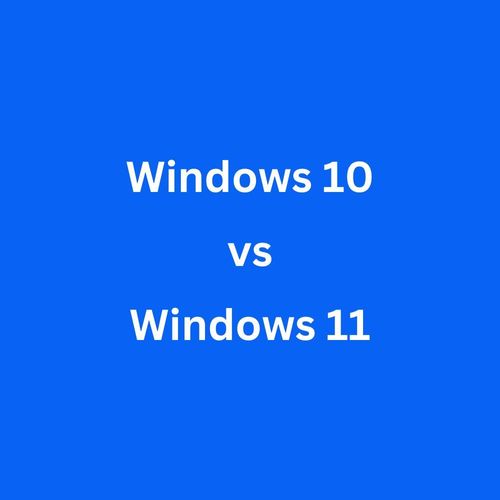Windows 11 vs Windows 10

As technology continues to evolve, so do our operating systems. Microsoft has introduced Windows 11, promising a host of new features and improvements over its predecessor, Windows 10. If you’re contemplating whether to upgrade or stick with what you know, this blog will delve into the key differences, advantages, and potential drawbacks of each system to help you make an informed decision.
A Fresh Look and Feel
One of the most striking changes in Windows 11 is its visual overhaul. The operating system sports a more modern interface, with a centred Start menu and taskbar, rounded corners, and a new set of icons that give it a sleek, contemporary feel. For users tired of the traditional look of Windows 10, this fresh design can be invigorating.
However, aesthetics aren’t everything. While Windows 11 offers a more streamlined experience, those who have grown accustomed to the Windows 10 layout may find the transition jarring. The centred Start menu, for instance, may take some getting used to, and features like Live Tiles have been replaced with a simpler grid of pinned apps.
Performance Improvements
Performance is a critical aspect to consider when evaluating an upgrade. Windows 11 comes with optimizations designed to enhance speed and efficiency. Microsoft claims that Windows 11 is faster than Windows 10, particularly in terms of boot times and application launch speeds. Additionally, it incorporates technologies like DirectStorage, which can significantly reduce load times for games by allowing them to load assets directly from the SSD.
For gamers, Windows 11 also introduces Auto HDR and improvements to the Windows gaming experience, making it an attractive option. However, for everyday users who primarily use their computers for web browsing, document editing, and media consumption, the performance differences might not be as noticeable.
Enhanced Multitasking Features
Multitasking is where Windows 11 shines. The new Snap Layouts and Snap Groups features allow users to easily organize and manage open windows. You can effortlessly snap windows into various configurations, making it easier to work on multiple tasks simultaneously. Virtual Desktops have also been revamped, allowing for more customization and organization.
For professionals and power users, these enhancements can significantly improve productivity. If you often find yourself juggling several applications at once, the multitasking capabilities of Windows 11 may justify the upgrade. On the other hand, if you’re a casual user who rarely pushes the limits of multitasking, Windows 10 may still serve you just fine.
Compatibility and System Requirements
Before upgrading, it's essential to take the system requirements into account. Windows 11 demands more stringent hardware specifications compared to Windows 10.
To install Windows 11, your PC must have a compatible 64-bit processor, at least 4 GB of RAM, and 64 GB of storage, along with UEFI firmware with Secure Boot capability and TPM version 2.0.
This means that some older machines may not be eligible for the upgrade, leading to frustration for users who wish to take advantage of the new features. If you’re using a relatively new PC, you’re likely in the clear, but those with older hardware may need to weigh the cost of a new machine against the benefits of Windows 11.
Software and Application Support
Another critical factor to consider is software compatibility. Windows 10 will continue to receive support and updates until October 2025, which means that for the next few years, you won’t be left in the lurch if you choose to stick with it. Many applications and tools are still optimized for Windows 10, and while most major software vendors are quickly adapting to Windows 11, there may still be some hiccups.
If you rely heavily on specific software for work or personal projects, it’s worth checking for compatibility with Windows 11 before leaping. In many cases, developers have already rolled out updates to support the new operating system, but it’s always better to be cautious.
Security Enhancements
Windows 11 places a significant emphasis on security. The requirements for TPM 2.0 and Secure Boot are aimed at providing a more secure environment, especially against threats like ransomware and malware. Microsoft’s commitment to security means that Windows 11 will likely offer a more secure user experience, which is an essential consideration for anyone concerned about digital threats.
Windows 10 has its security features, but as time goes on, newer systems tend to incorporate more advanced security measures. If security is a priority for you, moving to Windows 11 might be the better option.
Conclusion: Is It Worth It?
Deciding whether to upgrade from Windows 10 to Windows 11 ultimately depends on your specific needs, preferences, and hardware capabilities. If you’re drawn to a modern interface, enhanced multitasking features, and improved gaming performance, Windows 11 could be worth the investment. However, if you’re satisfied with your current setup, rely on older hardware, or prioritize software compatibility, sticking with Windows 10 for now may be the wiser choice.
Ultimately, the best approach is to evaluate your individual use case. Consider your hardware, the software you rely on, and how you use your computer daily. Whether you choose to upgrade or remain on Windows 10, both operating systems have their strengths, and you can’t go wrong with either choice for the time being.

